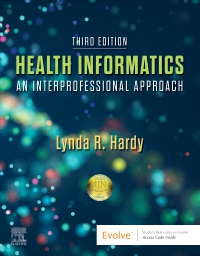
Health Informatics - Elsevier eBook on Vitalsource, 3rd Edition
Elsevier eBook on VitalSource

Show students how information technology intersects with today’s health care! Health Informatics: An Interprofessional Approach, 3rd Edition, follows the tradition of expert informatics educators Ramona Nelson and Nancy Staggers with new lead author, Lynda R. Hardy, to prepare students for success in today’s technology-filled healthcare practice. Concise coverage includes information systems and applications, such as electronic health records, clinical decision support, telehealth, mHealth, ePatients, and social media tools, as well as system implementation. New to this edition are topics that include analytical approaches to health informatics, increased information on FHIR and SMART on FHIR, and the use of health informatics in pandemics. This unique text continues to provide the content that garnered the first edition an American Journal of Nursing Book of the Year award!
-
- UPDATED! Chapters reflect the current and evolving practice of health informatics, using real-life healthcare examples to show how informatics applies to a wide range of topics and issues
- NEW! Strategies to promote healthcare equality by freeing algorithms and decision-making from implicit and explicit bias are integrated where applicable
- NEW! The latest AACN domains are incorporated throughout to support BSN, Master’s, and DNP programs
- NEW! Greater emphasis on the digital patient and the partnerships involved, including decision-making
- Chapters written by experts in the field provide the most current and accurate information on continually evolving subjects like evidence-based practice, EHRs, PHRs, mobile health, disaster recovery, and simulation
- Objectives, key terms, and an abstract at the beginning of each chapter provide an overview of what each chapter will cover
- Case studies and discussion questions at the end of each chapter encourage higher-level thinking that can be applied to real world experiences
- Conclusion and Future Directions discussion at the end of each chapter reinforces topics and expands on how the topic will continue to evolve
- Open-ended discussion questions at the end of each chapter enhance students’ understanding of the subject covered
- mHealth chapter discusses all relevant aspects of mobile health, including global growth, new opportunities in underserved areas, governmental regulations on issues such as data leaking and mining, implications of patient-generated data, legal aspects of provider monitoring of patient-generated data, and increased responsibility by patients
- Important content, including FDA- and state-based regulations, project management, big data, and governance models, prepares students for one of nursing’s key specialty areas
-
- UPDATED! Chapters reflect the current and evolving practice of health informatics, using real-life healthcare examples to show how informatics applies to a wide range of topics and issues
- NEW! Strategies to promote healthcare equality by freeing algorithms and decision-making from implicit and explicit bias are integrated where applicable
- NEW! The latest AACN domains are incorporated throughout to support BSN, Master’s, and DNP programs
- NEW! Greater emphasis on the digital patient and the partnerships involved, including decision-making
-
SECTION 1 Fundamental Knowledge in Health Informatics
1. An Introduction to Health Informatics
2. Theoretical Frameworks
3. Health Systems and Information Flow
4. Informatics-Related Standards and Standard Setting
5. Evaluation of Health Information Systems—Purposes, Theories, and Methods
SECTION 2 Health Information Systems and Applications
6. Technical Infrastructure
7. The Electronic Health Record and Precision Care
8. Administrative Applications in Healthcare
9. Community Health Systems
10. Public Health Informatics
SECTION 3 Decision-Making and the Digitally Engaged Patient
11. Evidence-Based Informatics
12. Clinical Decision Support
13. The Evolving ePatient
14. Digital Health: Managing Health and Wellness
15. Personal Health Records
16. Social Media Tools for Health Informatics
SECTION 4 Lifecycle Management
17. Project Management Principles
18. Strategic Planning and Information System Selection
19. Contract Negotiations and Software Licensing
20. Implementing and Upgrading an Information System
21. Downtime and Disaster Recovery for Health Information Systems
SECTION 5 Usability, Analytics, and Education
22. Improving the User Experience for Health Information Technology
23. Data Science and Analytics in Healthcare
24. Safety and Quality Initiatives in Health Informatics
25. Informatics in the Curriculum
26. Distance Education—A New Frontier
SECTION 6 Data Governance, Legal, and Regulatory Issues
27. Legal Issues, Federal Regulations, and Accreditation
28. Privacy and Security
29. MACRA and Interoperability
30. Health Policy and Health Informatics
31. Health Information Technology Governance
SECTION 7 Global and Future Perspectives in Health Informatics
32. Global Health Informatics
33. Informatics and the Future of Healthcare




 as described in our
as described in our 